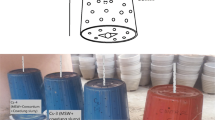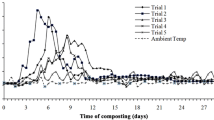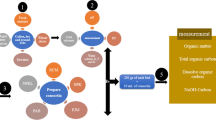Abstract
Background
Different bulking agents are used in the compost of dewatered sludge (DWS). The aim of this study has been using of indigenous bulking agents (IBAs) in the enhancing of the DWS class of municipal wastewater from class B to class A and complementary stabilization of it for production of green manure in Sari city, Iran.
Methods
Three IBAs including the Saccharum Wastes (SW), Citrus Purning Wastes (CPW) and Phragmites Australis (PA) from eight IBAs were selected to be compared with the sawdust (SD) that was as a control bulking agent. Five turned windrow piles were constructed on a full scale and on base of optimal C/N equal 25.All experiments were performed on the base of the standard methods on initial mix and final compost.
Results
Among five windrow piles, P5 was been the best pile with a weighting ratio of DWS to IBAs (DWS: SW: CPW: PA) equal 1: 0.2: 0.24: 0.28. Pile P1 with weighting ratio DWS: SW equal 1: 0.6, Pile P3 with weighting ratio DWS: PA equal 1: 0.84, Pile P2 with weighting ratio DWS: CPW equal 1: 0.73 and Pile P4 with weighting ratio DWS: SD equal 1: 0.57 were placed in the next rounds. The results showed that the class of DWS enhanced to Class A for about 80 to 97 days and complementary stabilization of DWS by IBAs was done well and produced green manure in term of organic matter, potassium, germination index, PH, C/N and electrical conductivity had reached to the Grade 1 of Iran’s manure 10716 standard and in term of phosphorus and moisture had reached to the Grade 2 of this standard. Also heavy metals were below the maximum permissible of standards.
Conclusion
Using of IBAs, had a higher efficiency than the control bulking agent (sawdust) in enhancing sludge class and its stabilization, so that using of them in combination (mix of IBAs) had the highest efficiency and respectively, Saccharum Wastes (SW), Phragmites Australis (PA), Citrus pruning wastes (CPW) were placed in the next round, and sawdust was placed after them. By adding suitable IBAS, with an optimal ratio in turned windrow method, the class of DWS of sari WWTP enhanced to Class A and complementary stabilization of DWS has been well done and the produced green manure has been reached to agricultural standards and can be safely used in agriculture.









Similar content being viewed by others
References
Głąb T, et al. Effects of co-composted maize, sewage sludge, and biochar mixtures on hydrological and physical qualities of sandy soil, in Geoderma. Elsevier BV. 2018:27–35.
Komilis D, Kontou I, Ntougias S. A modified static respiration assay and its relationship with an enzymatic test to assess compost stability and maturity. Bioresour Technol. 2011;102(10):5863–72.
Lu L-A, et al. High-rate composting of barley dregs with sewage sludge in a pilot scale bioreactor. Bioresour Technol. 2008;99(7):2210–7.
Mosquera-Losada MR, Muñoz-Ferreiro N, Rigueiro-Rodríguez A. Agronomic characterisation of different types of sewage sludge: Policy implications. Waste Manag. 2010;30(3):492–503.
Fountoulakis MS, et al. Fate and effect of linuron and metribuzin on the co-composting of green waste and sewage sludge. Waste Manag. 2010;30(1):41–9.
Hait S, Tare V. Optimizing vermistabilization of waste activated sludge using vermicompost as bulking material. Waste Manag. 2011;31(3):502–11.
Smith S. A critical review of the bioavailability and impacts of heavy metals in municipal solid waste composts compared to sewage sludge. Environ Int. 2009;35(1):142–56.
Białobrzewski I, et al. Model of the sewage sludge-straw composting process integrating different heat generation capacities of mesophilic and thermophilic microorganisms. Waste Manag. 2015;43:72–83.
Kulikowska D, Sindrewicz S. Effect of barley straw and coniferous bark on humification process during sewage sludge composting. Waste Manag. 2018;79:207–13.
Hao Z, Yang B, Jahng D. Spent coffee ground as a new bulking agent for accelerated biodrying of dewatered sludge. Water Res. 2018;138:250–63.
Meng L, et al. Improving sewage sludge composting by addition of spent mushroom substrate and sucrose. Bioresour Technol. 2018;253:197–203.
Zhang D, et al. Performance of co-composting sewage sludge and organic fraction of municipal solid waste at different proportions. Bioresour Technol. 2018;250:853–9.
Yu Z, et al. The distinctive microbial community improves composting efficiency in a full-scale hyperthermophilic composting plant. Bioresour Technol. 2018;265:146–54.
Cai L, et al. Bacterial communities and their association with the bio-drying of sewage sludge. Water Res. 2016;90:44–51.
Nikaeen M, et al. Respiration and enzymatic activities as indicators of stabilization of sewage sludge composting. Waste Manag. 2015;39:104–10.
Yañez R, Alonso JL, Díaz MJ. Influence of bulking agent on sewage sludge composting process. Bioresour Technol. 2009;100(23):5827–33.
Roca-Perez L, et al. Composting rice straw with sewage sludge and compost effects on the soil–plant system. Chemosphere. 2009;75:781–7.
Ponsá S, Pagans E, Sánchez A. Composting of dewatered wastewater sludge with various ratios of pruning waste used as a bulking agent and monitored by respirometer. Biosyst Eng. 2009;102(4):433–43.
Zhang S, et al. Effectiveness of bulking agents for co-composting penicillin mycelial dreg (PMD) and sewage sludge in pilot-scale system. Environ Sci Pollut Res. 2015;23(2):1362–70.
Lai C-H, Chen K-S, Wang H-K. Influence of rice straw burning on the levels of polycyclic aromatic hydrocarbons in agricultural county of Taiwan. J Environ Sci. 2009;21(9):1200–7.
Guo R, et al. Effect of aeration rate, C/N ratio and moisture content on the stability and maturity of compost. Bioresour Technol. 2012;112:171–8.
Tao J, et al. Composition of waste sludge from municipal wastewater treatment plant. Procedia Environ Sci. 2012;12:964–71.
Alidadi H, Parvaresh AR. Combined Compost and Vermicomposting Process in The Treatment and Bioconversion of Sludge. Iran J Environ Health Sci Eng. 2005;2(4).
Zazouli MA, D.S. Solid waste & compost Sampling and analysis Guideline, vol. 1. Tehran: Avaye ghalam; 2014.
Mori T, Narita A. Composting of municipal sewage sludge mixed with rice hulls. Soil Sci Plant Nutr. 1981;27(4):477–86.
Parvaresh A, Shahmansouri MR, Alidadi H. Determination of carbon/nitrogen ratio and heavy metals in bulking agents used for sewage composting. Iran J Public Health. 2004;33:20–3.
Cai Q-Y, et al. Concentration and speciation of heavy metals in six different sewage sludge-composts. J Hazard Mater. 2007;147(3):1063–72.
Rihani M, et al. In-vessel treatment of urban primary sludge by aerobic composting. Bioresour Technol. 2010;101(15):5988–95.
Ammari T. Composting sewage sludge amended with different sawdust proportions and textures and organic waste of food industry – assessment of quality. Environ Technol. 2012;33(14):1641–9.
Gea T, et al. Optimal bulking agent particle size and usage for heat retention and disinfection in domestic wastewater sludge composting. Waste Manag. 2007;27(9):1108–16.
Zorpas AA, Loizidou M. Sawdust and natural zeolite as a bulking agent for improving quality of a composting product from anaerobically stabilized sewage sludge. Bioresour Technol. 2008;99(16):7545–52.
Omrani GA. Management Collection Transportaton Sanitary Landfill Composting, vol. 5. Tehran: Azad University scientific publishings center; 2017.
Tchobanglous G, Teisn H, Vigil S. Integrated Solid Waste Management: Engineering principles and management issues, vol. 2. 1nd ed. Tehran: Khaniran; 2009.
Zhang D, et al. Co-biodrying of sewage sludge and organic fraction of municipal solid waste: role of mixing proportions. Waste Manag. 2018;77:333–40.
Asgharzadeh F, et al. Evaluation of cadmium, Lead and zinc content of compost produced in Babol composting plant. Iranian Journal Of Health Sciences. 2014;2(1):62–7.
Tang X, et al. Nutrient Removal in Pilot-Scale Constructed Wetlands Treating Eutrophic River Water: Assessment of Plants, Intermittent Artificial Aeration and Polyhedron Hollow Polypropylene Balls. Water Air Soil Pollut. 2008;197(1–4):61–73.
Picard CR, Fraser LH, Steer D. The interacting effects of temperature and plant community type on nutrient removal in wetland microcosms. Bioresour Technol. 2005;96(9):1039–47.
Chang JI, Hsu T-E. Effects of compositions on food waste composting. Bioresour Technol. 2008;99(17):8068–74.
Kumar M, Ou Y-L, Lin J-G. Co-composting of green waste and food waste at low C/N ratio. Waste Manag. 2010;30(4):602–9.
Moretti SML, Bertoncini EI, Abreu-Junior CH. Composting sewage sludge with green waste from tree pruning. Sci Agric. 2015;72(5):432–9.
Mokhtari M, et al. Evaluation of Stability Parameters in In-Vessel Compositing of Municipal Solid Waste.Iran. J Environ Health Sci Eng. 2011;8(4):325–332.
Nafez A, Nikaeen M. Evaluation of Stability and Maturity Parameters in Wastewater Sludge Composting with Different Aeration on Strategies and a Mixture of Green Plant Wastes as Bulking Agent. Fresenius Environ Bull:PSP 2015. 24.
Dumontet S, Dinel H, Baloda S. Pathogen reduction in sewage sludge by composting and other biological treatments. Biol Agric Hortic. 1999;16:409–30.
Ramirez Coutiño V, et al. Evaluation of the composting process in digested sewage sludge from a municipal wastewater treatment plant in the city of San Miguel de Allende, Central Mexico. Rev Int Contam Ambie. 2013;29:89–97.
Edrissbazrafshan, et al. Co-composting of dewatered sewage sludge with sawdust. Pak J Biol Sci. 2006;9(8):1580–3.
Navarro I, Jiménez B. Evaluation of the WHO helminth eggs criteria using a QMRA approach for the safe reuse of wastewater and sludge in developing countries. Water Sci Technol. 2011;63(7):1499–505.
Villaseñor J, Rodríguez L, Fernández FJ. Composting domestic sewage sludge with natural zeolites in a rotary drum reactor. Bioresour Technol. 2011;102(2):1447–54.
Zhang L, Sun X. Changes in physical, chemical, and microbiological properties during the two-stage co-composting of green waste with spent mushroom compost and biochar. Bioresour Technol. 2014;171:274–84.
An C-J, et al. Performance of in-vessel composting of food waste in the presence of coal ash and uric acid. J Hazard Mater. 2012;203-204:38–45.
Meunchang S, Panichsakpatana S, Weaver RW. Co-composting of filter cake and bagasse; by-products from a sugar mill. Bioresour Technol. 2005;96(4):437–42.
Zazouli MA, et al. Evaluation of cow manure effect as bulking agent on concentration of heavy metals in municipal sewage sludge vermicomposting. J Mazandaran Univ Med Sci. 2015;25(124):152–69.
Shamuyarira K, Gumbo J. Assessment of heavy metals in municipal sewage sludge: a case study of Limpopo Province, South Africa. Int J Environ Res Public Health. 2014;11(3):2569–79.
Zorpas AA, Inglezakis VJ, Loizidou M. Heavy metals fractionation before, during and after composting of sewage sludge with natural zeolite. Waste Manag. 2008;28(11):2054–60.
Aghili SM, et al. Heavy metal concentrations in dewatered sludge of wastewater treatment Plant in Sari, Iran. J Mazandaran Univ Med Sci. 2019;28(170):152–9.
Acknowledgements
The authors would like to thank from the Mazandaran Wastewater Company for financially supporting and Faculty of health of the Mazandaran Medical Science University for collaboration of this research project (Project No: 2551/150).
Author information
Authors and Affiliations
Corresponding author
Ethics declarations
Conflict of interest
The authors would like to declare that there is no conflict of interest with this research and in the publication.
Additional information
Publisher’s note
Springer Nature remains neutral with regard to jurisdictional claims in published maps and institutional affiliations.
Rights and permissions
About this article
Cite this article
Aghili, S.M., Mehrdadi, N., Aminzadeh, B. et al. Using of indigenous bulking agents (IBAs) in complementary stabilization and enhancing of dewatered sludge class B to class a on a full scale. J Environ Health Sci Engineer 17, 767–777 (2019). https://doi.org/10.1007/s40201-019-00393-8
Received:
Accepted:
Published:
Issue Date:
DOI: https://doi.org/10.1007/s40201-019-00393-8




